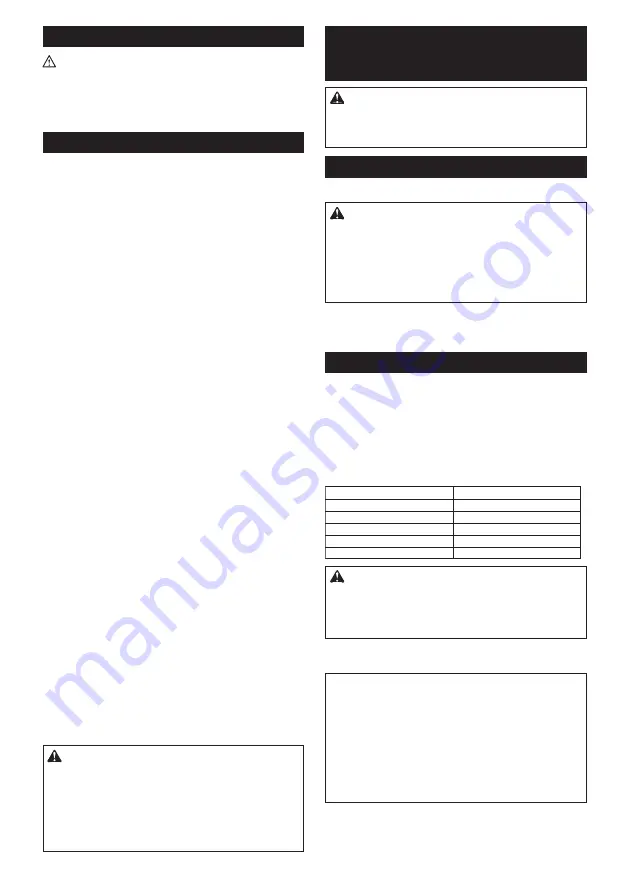
5 ENGLISH
General Power Tool Safety Warnings
WARNING Read all safety warnings and all instruc
-
tions.
Failure to follow the warnings and instructions may
result in electric shock, fire and/or serious injury.
Save all warnings and instructions for
future reference.
HAMMER SAFETY WARNINGS
1.
Wear ear protectors.
Exposure to noise can
cause hearing loss.
2.
Use auxiliary handle(s), if supplied with the
tool.
Loss of control can cause personal injury.
3.
Hold power tool by insulated gripping surfaces,
when performing an operation where the cutting
accessory may contact hidden wiring or its own
cord.
Cutting accessory contacting a "live" wire may
make exposed metal parts of the power tool "live"
and could give the operator an electric shock.
4.
Wear a hard hat (safety helmet), safety glasses and/
or face shield. Ordinary eye or sun glasses are NOT
safety glasses. It is also highly recommended that
you wear a dust mask and thickly padded gloves.
5.
Be sure the bit is secured in place before
operation.
6.
Under normal operation, the tool is designed to
produce vibration. The screws can come loose
easily, causing a breakdown or accident. Check
tightness of screws carefully before operation.
7.
In cold weather or when the tool has not been
used for a long time, let the tool warm up for
a while by operating it under no load. This
will loosen up the lubrication. Without proper
warm-up, hammering operation is difficult.
8.
Always be sure you have a firm footing.
Be sure no one is below when using the tool in
high locations.
9.
Hold the tool firmly with both hands.
10.
Keep hands away from moving parts.
11.
Do not leave the tool running. Operate the tool
only when hand-held.
12.
Do not point the tool at any one in the area
when operating. The bit could fly out and
injure someone seriously.
13.
Do not touch the bit or parts close to the bit
immediately after operation; they may be
extremely hot and could burn your skin.
14.
Do not operate the tool at no-load unnecessarily.
15.
Some material contains chemicals which may
be toxic. Take caution to prevent dust inhala
-
tion and skin contact. Follow material supplier
safety data.
SAVE THESE INSTRUCTIONS.
WARNING:
DO NOT let comfort or famil
-
iarity with product (gained from repeated
use) replace strict adherence to safety rules
for the subject product.
MISUSE or failure to follow the safety rules
stated in this instruction manual may cause
serious personal injury.
FUNCTIONAL
DESCRIPTION
CAUTION:
•
Always be sure that the tool is switched off and
unplugged before adjusting or checking function
on the tool.
Switch action
►
Fig.1:
1.
Switch lever
CAUTION:
•
Before plugging in the tool, always check to see
that the tool is switched off.
•
Switch can be locked in "ON" position for ease
of operator comfort during extended use. Apply
caution when locking tool in "ON" position and
maintain firm grasp on tool.
To start the tool, push the switch lever "ON (I)" on the
left side of the tool. To stop the tool, push the switch
lever "OFF (O)" on the right side of the tool.
Speed change
►
Fig.2:
1.
Adjusting dial
The blows per minute can be adjusted just by turning
the adjusting dial. This can be done even while the tool
is running. The dial is marked 1 (lowest speed) to 5 (full
speed).
Refer to the table below for the relationship between
the number settings on the adjusting dial and the blows
per minute.
Number on adjusting dial
Blows per minute
5
4
3
2
1
2,650
2,400
1,750
1,300
1,100
CAUTION:
•
The speed adjusting dial can be turned only as
far as 5 and back to 1. Do not force it past 5 or
1, or the speed adjusting function may no longer
work.
For Model HM1111C only
NOTE:
•
Blows at no load per minute becomes smaller
than those on load in order to reduce vibration
under no load, but this does not show trouble.
Once operation starts with a bit against con
-
crete, blows per minute increase and get to the
numbers as shown in the table. When tempera
-
ture is low and there is less fluidity in grease,
the tool may not have this function even with the
motor rotating.






































